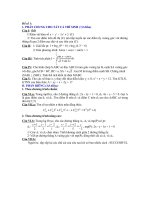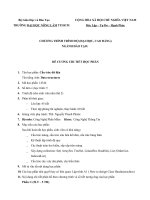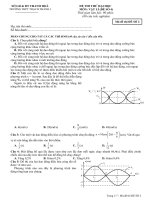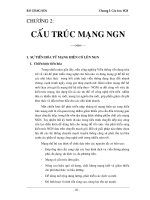CẤU TRÚC WRITING TASK 1 v1 2 25082017 (1)
Bạn đang xem bản rút gọn của tài liệu. Xem và tải ngay bản đầy đủ của tài liệu tại đây (1.2 MB, 16 trang )
CÁC CẤU TRÚC LẬP LUẬN WRITING TASK 1
ORIGINAL SENTENCE
PARAPHRASED SENTENCE
NOTE
OPENING (1 sentence)
The graph below gives
information about car
ownership in Britain from
1971 to 2007.
The graph below shows
the unemployment figures
amongst women of
different age groups.
(1) The line graph (2) illustrates (3) the proportion of
(4) households using cars in the UK (5) during 1971
and 2007.
(1)The line graph (2) demonstrates (3) percentages of
(4) unemployed women in (5) 8 age groups.
1. The graph = the line/bar/pie graph
2. Gives = illustrates/ demonstrates/ indicates
3. Information = the proportion of (%, numbers)/ the
number of (countable nouns)/ the amount of
(uncountable nouns)/ the percentage of (%)
4. Car ownership = household using cars/ people who
used cars/ people using cars
5. 1971 and 2007 = during 1971 and 2007/ over a period
of 36 years/ over a 36-year period
1. As explained
2. As explained
3. As explained
4. Unemployment figures = unemployed women
5. Different age groups = 8 age groups
*age group = 20-year-old (group) = (the) group of age 20 =
the age group of 20
OVERVIEW (1-2 sentences)
Overall, car ownership in the UK increased during the
given period. While the percentage of households
with two cars increased, there was a decrease in the
proportion of families without any cars.
/>
1. Overall/ it can be clearly seen that … từ nối vào
overview
2. While/whereas cấu trúc câu so sánh
3. Cấu trúc There was an increase/decline in ….
It can be clearly seen that age groups of 18 and of 45
have the highest unemployment rate.
So sánh hơn nhất the highest unemployment rate
Overall, from 2015, oil consumption in Western
Europe/Japan and also in the US is predicted to
decline, in contrast to the expected increase in China
and the Middle East. The US will remain the major
consumer throughout the period.
1. Overall từ nối
2. Is predicted to/ is anticipated to/ is expected to để chỉ
số liệu sẽ có trong tương lai
3. In contrast to + Noun (thay cho cấu trúc while/whereas)
= compared to/with + noun (there was a 20% reduction
in oil consumption in China compared with/to 2010)
4. The major consumer = the customer consumed the
most
BODY (4 SENTENCES/ PARA)
BASIC
From 1990 to 2010, there was a significant increase in
oil production in Saudi Arabia.
There was a significant/dramatic/slight/sharp increase/
decline/ decrease in…
The other countries saw a slight rise in oil production
over the period.
Over the period, the consumer price index rose
steadily from around 60 in 1979 to over 200 in 2009
1999/China saw/witnessed/experienced a dramatic rise
in…
The number/proportion/amount of… increased/declined…
ADVANCED
In 1971, the proportion of households without a car
stood at nearly 50%, slightly higher than that of
households having one car, at just over 42%.
By contrast, only nearly 9% of British households
owned 2 cars and a mere 1 % of households owned
more than 3 cars, which was the lowest recorded
figure.
/>
1. Cấu trúc the proportion/ number of…
2. Cấu trúc Adj clause rút gọn which was higher than… ->
,higher than…
3. That of = the proportion of household having one car.
1. By contrast/ Meanwhile so sánh
2. Cấu trúc only 9% of… verb (đưa số liệu lên đầu)
3. Dùng and để nối câu
4. Mệnh đề tính ngữ nối thêm , which was…
From 1971 onwards, while the percentage of families
owning one car remained stable, that of households
without any car dropped to approximately 25% in
2007.
1. So sanh while/whereas
2. That of = the figure for = the level of = the percentage of
1. 35% of energy – số liệu lên đầu
2. And this proportion = energy came from coal in Sweden
Có thể thay bằng cấu trúc but this then fell/declined
to…
3. To finish at… dùng để nói số liệu nằm ở đâu, thường là
những năm cuối biểu đồ
4. Cấu trúc rút gọn the highest of the four countries
5. Cấu trúc while và that of
1. To follow a similar pattern khi nói về số liệu nào có xu
hướng giống nhau
Energy production from coal in Germany followed a
2. Beginning – rút ngọn adj clause = which began
similar pattern, beginning the period at just under
3. Falling – cấu trúc đồng dạng với beginning
60% and falling significantly, though unlike Denmark it 4. Though unlike + Noun = while/whereas
fell to a low of only 5% in 2007 and then increased
5. It = the proportion of Denmark = energy production of
again to approximately 18%.
Denmark
6. And then từ nối
7. Fell – increased cấu trúc đồng dạng
1. At 25.7% đưa số liệu lên đầu làm trạng ngữ
At 25.7%, nursing was the second most popular
2. Noun was the most popular subject … so sánh nhất
subject to study, but this fell significantly to only 14%
3. But nối câu
two years later.
4. This thay cho nursing
1. In terms of = Regarding = with regard to = about
In terms of food, the figures for both countries were
2. Cấu trúc the figures for ….
similar, at 27% and 24% for Malaysia and Japan
3. 24% for Malaysia – số liệu của Malaysia đưa lên đầu và
respectively.
chú ý FOR k phải OF
4. Respectively = theo thứ tự lần lượt là…
35% of energy came from coal in Sweden in 1995, and
this proportion gradually declined over the period to
finish at approximately 28% in 2010, the highest of
the four countries, while the percentage produced in
France remained just under that of Sweden over the
15-year period.
/>
In Japan, this accounted for 6% of the total, while 20%
of household spending went on transport.
1. To account for = to make up = to constitute
2. While cấu trúc so sánh
White, which constituted 26%, is about four times as
popular as blue, which made up 8%.
1. Which constitutes 26%, which made up 8% - mệnh đề
quan hệ
2. So sánh bằng ‘is four times as adj as’
*So sánh bằng:
- Company A has nearly (twice/half/a quarter) as many
employees as company B
- The number of employees doubled/ increased twofold
from March to May.
Theft, of which there were 94 cases per 10,000
people, is just under four times more common than
other crimes, 25 cases.
1. Of which cấu trúc mệnh đề quan hệ theo sau là there
were
2. So sánh hơn gấp 4 lần, four times more common than
/>
PRACTICE EXERCISE WRITING TASK 1
NGUỒN: TỔNG HỢP
Line graph
1. The graph below gives information about car ownership in Britain from 1971 to 2007.
The graph illustrates the proportion of households using
cars in the UK during 1971 and 2007.
It is noticeable that car ownership in the UK increased
during the given period. While the percentage of
households with two cars increased, there was a decrease
in the proportion of families without any cars.
In 1971, the proportion of households without a car stood
at nearly 50%, slightly higher than that of households
having one car, at just over 42%. By contrast, only nearly
9% of British households owned 2 cars and a mere 1 % of
households owned more than 3 cars, which was the lowest
recorded figure.
From 1971 onwards, while the percentage of families
owning one car remained stable, that of households
without any car dropped to approximately 25% in 2007. By
contrast, the proportion of families in the UK who owned
two cars increased slightly to nearly 26% and the figure for families with more than two cars rose by almost 5%.
/>
2. The graph shows the amounts spent on apparel on the internet in USA and Japan between 1999 and 2003.
The graph compares amounts of money spent online on apparel in
USA and Japan starting from 1999 and 2003. It is clear that
although at first Japanese buyers were spending much more
money than Americans did; as the years went by the spending
habits of 2 countries became almost identical.
In 1999 Japan was spending on apparel almost twice as much as
USA (10 versus 5 Millions of dollars). In the following year apparel
expenses of both Japan and USA grew even bigger to 12 and 10
million respectively. The only year when expenses plunged in both
countries was 2001, when USA spent only 8 and Japan reached the
bottom of 7 million.
Two following year, 2002 and 2003 showed rapid increase in
apparel sales in both countries. In 2002 USA spent about 10 million
and Japan’s numbers were very close (18 millions). Online apparel
sales became even more popular in 2003, pushing the figures to
the peak of 20 million in both Japan and USA.
/>
Bar graph
1. The bar chart shows figures of annual coffee and meat consumption.
The bar chart compares the amounts of coffee and meat
consumed every year in Norway, France, Germany, USA,
Russia, China and Japan. Overall, Asian group of countries
has similar consumption numbers of both coffee and meat.
The lowest rates of coffee consumption are recorded in
China and Japan (2 and 3 kg per person respectively). The
next three countries have higher rates, consumption of
coffee in USA totals in 4 kg per person, while France and
Russia have equal consumption rates of 5 kg per person. The
highest numbers belonged to Germany and Norway,
7 and 9 kg per person respectively.
Meat consumption numbers were much higher in all
countries; the highest numbers were recorded in USA (122
kg per person) and the lowest in Japan. Meat consumption in
Russia (45) and China (47) is similar to that of Japan (42).
Three other countries have much higher numbers, starting with Norway (60) and progressing through France (72) to Germany which
consumes about twice as much as Japan (87 kg per person).
/>
2. The bar chart compares consumer spending on six different items in Germany, Italy, France and Britain.
The bar chart compares consumer spending on
six different items in Germany, Italy, France and
Britain.
It is noticeable that people in Britain spent
considerably more money than people living in
the other three nations on all six products. Of
the six items, photographic film was spent the
most money on.
People in Britain spent just over £170,000 on
photographic film, which was the highest
recorded figure on the chart. By contrast, the
lowest overall spenders were German, with
roughly the same figures (just under £150,000)
for each of the six items.
Levels of spending on toys were similar/equal
in France and Italy, at nearly £160,000.
However, the amount spent by French on
photographic film and CDs was at £165,000 and nearly £158,000 respectively, slightly higher than that of Italians. By contrast, people
in Italy paid out more for personal stereos, tennis racquets and perfumes. French people spent around £145,000 on tennis racquet,
which was the lowest figure shown on the chart.
/>
3. The graph shows the percentage of population in urban areas around the world from 1950 and 2030.
The bar chart compares the rates of people
living in cities around the world in the years
1950, 2007 and projections in 2030.
It is noticeable that the proportions of city
dwellers increase around the world between
1950 and 2030. North America is expected to
see the most significant changes in its urban
population.
In 1950, the percentage of city dwellers in
North America doubled the world average (at
64% and 29% respectively), followed by
Europe (52%) and Latin America Caribbean
(42%). By contrast, much lower proportions of Asians and Africans were living in the inner city, at around 16%.
In the next 56 years, while there was a steady increase in the figures for North America and Europe, rising to 79% and 72%
respectively, urban population in Latin America Caribean doubled to 76%. Similarly, Asia and Africa had a twofold increase in the
percentage of city dwellers, at about 40%.
Looking into the future, the percentage of population living in the city in North America is predicted to reach a peak of 87% in 2030,
whereas that of the world will increase by 11% to 60%. Around half of Asian and African population is anticipated to live in urban
areas.
/>
Table
1. The table below shows the monthly expenditure of an average Australian family in 1991 and 2001.
The table illustrates the amount of
monthly spending of Australian
households on six different types of goods
for the years 1991 and 2001.
It is noticeable that there was an overall
increase in monthly spending of Australian
households. These families spent more
money on Food, Electricity and Water,
Housing and Other goods and services.
In 2001, expenditure on Non-essential
goods and services was highest among six
types of goods, with a rise of 20 Australian
Dollars (AUD). Similarly, Australian
household spending on Food, the second
most popular item, rose from 155 AUD to 160 AUD. It was considerably higher than those for Electricity and Water and Housing, at
120 AUD and 100 AUD respectively.
In stark contrast, the amount of money spent on the remaining two items declined. Monthly spending on Transport witnessed a
dramatic fall from 70 AUD in 1991 to 45 AUD in 2001. Spending on Clothing was lowest, which declined from 30 AUD to 20 AUD.
/>
2. The table below gives information about Favorite Pastimes in different countries. (unit: %)
The table illustrates seven different types of
activities that are preferred in pastimes with
residents aged between 30 and 50 from different
nations.
It is noticeable that Reading, Hobbies and TV are
three most popular recreational activities among
all countries. By contrast, the least common
recreations are Sport, Beach, Music and Sleep.
Of the most common categories, the percentages
of middle-aged people choosing reading are
similar among Japanese, Koreans and Chinese
people, at around 60%. While about 60% of
Canadians, Australians and Americans spend freetime watching TV, the figure for China is considerably lower, at 15%. By contrast,
China has the highest level of people enjoying hobbies, at 50%, compared to only 20% of France and England.
With regard to the less common categories, there are around 21% -30% of people in 30-50 age group being involved in sports in
each country, except for France, England and Japan as there are no figures recorded. The percentages of people interested in
listening to music, going to the beach or sleeping in all countries are relatively insignificant.
/>
Pie chart
1. The pie charts show the amount of revenue and expenditures over a year of a children’s charity in the USA.
The pie charts illustrate the distribution of revenue
sources and expenditures during a year of a charity for
children in the US.
Overall, the charity relied on Donated Food as its
principal revenue source, while it spent the most money
on Program Services. It is also noticeable that the total
amount of incomes just exceeded expenditures.
This children’s charity received Donated food as its main
source of revenue, accounting for 86.6% of the total
revenue. The second significant source was generated
from Community Contributions, constituting 10.4%. Income from Program Revenue contributed much less, at 2.2%. The remaining sources from
Investment income, Government Grants and Other incomes represented a disproportionately small shares, occupying 0.8% collectively.
Concerning expenditures, Program services constituted the largest cost to the charity, at 95.8%. Its expense on Fundraising and Management
and General were significantly lower, representing only 2.6% and 1.6% respectively.
/>
2. The charts below give information on the ages of the populations of Yemen and Italy in 2000 and projections for 2050
The pie charts compares Yemen and Italy in terms of its
population in the year 2000 and projected population in
2050.
Overall, aged population in both countries will increase
during the given period. Italy had older population than
Yemen in 2000 and the same is anticipated in next five
decades.
Half of Yemeni population were under 14 years old in
2000, compared to just over 14% of Italians. While the
lowest share in Yemeni population (nearly 4%) was 60
years old or above, that of Italy was much higher, at 24%.
Similarly, the 15-59 age group in Yemen accounted for just
over 46%, much lower than that of Italy, representing 62%.
It is envisaged that the percentage of the youngest bracket
in Yemen will drop to 37% in 2050 and that of Italy to
11.5%. While the proportion of 15-59 age group in Yemen
will increase to 57.3%, that of Italy will decrease by 15%.
The oldest bracket in both countries will show an upward
trend, with a much higher rise in Italy, growing to 5.7%
and 42.3% respectively.
/>
Process
The diagram presents the manufacturing process of two types
of tea, pu-erh raw tea and pu-erh ripe tea. Although the first
three stages are the same for both teas, it can be seen that
the methods of production differ in the final stages, which
accounts for the resulting variations in the two teas.
First, the tea leaves that have been picked are pan fried in
order to inactivate the enzymes. Following this, the tea is
rolled and afterwards spread out on a round mat so that it can
dry under the sun. Once it has been dried, the loose raw tea is
ready to be turned into either ripe tea or raw tea. This is
where the process diverges.
To make pu-erh ripe tea, the loose tea is fermented by being
left to mold. Having completed the fermentation stage, the
resulting loose ripe tea is then compressed, after which the
tea is ready for sale. Regarding the alternative process, before
being ready for sale as vintage raw tea, the loose tea is first
compressed, and then left to age by storage.
/>
The flow chart shows how waste paper is
recycled.
It is clear that there are six distinct stages in
this process, from the initial collection of
waste paper to the eventual production of
usable paper.
At the first stage in the paper recycling
process, waste paper is collected either from
paper banks, where members of the public
leave their used paper, or directly from
businesses. This paper is then sorted by hand
and separated according to its grade, with
any paper that is not suitable for recycling
being removed. Next, the graded paper is
transported to a paper mill.
Stages four and five of the process both involve cleaning. The paper is cleaned and pulped, and foreign objects such as staples are
taken out. Following this, all remnants of ink and glue are removed from the paper at the de-inking stage. Finally, the pulp can be
processed in a paper making machine, which makes the end product: usable paper.
/>
Maps
The map illustrates the changes that have occurred in
Templeton, a seaside resort, over a 10 year period
beginning in 1990 and ending in 2005. The most noticeable
change is the replacement of many green areas with
several major infrastructure projects.
To begin, there were several major changes to transport in
the town. An airport has been built beside the river on the
outskirts of the town. In addition to this, a ferry port was
constructed on the far east coastline, with a new railway
extension line passing by the ferry port, continuing along
the coast and crossing over a new bridge so it connects to
the west side of town.
There have also been changes to the business sector in
Templeton. A factory can be seen in the south east of the
town behind the new railway line, and a supermarket has
been built over the river in the west of Templeton, running
alongside a new road.
The residential landscape has also altered, particularly on
the west side of town, where large apartment blocks now
stand in place of the houses.
/>









